�
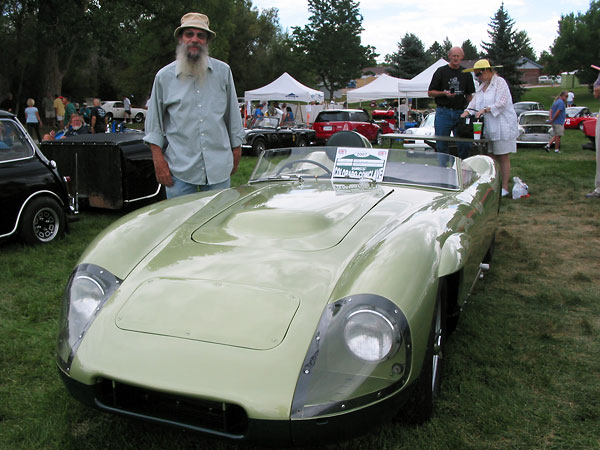
�
MG's EX186 Prototype: Abingdon Skunkworks LeMans Project
� Owners: Joe and Cathy Gunderson� � City: Littleton, CO
� Model: prototype (based on an MGA Twin-Cam)
� Engine: MGA Twin-Cam
� Restoration by: owner
�
MG Builds a LeMans Prototype
��
MG's senior management had every intention of winning at LeMans in 1961. Their appetite �
for victory had been whetted by MG's last-minute three-car entry in the 1955 race. �
That race went very well indeed: the brand-new MGA model proved itself by placing �
twelfth overall and fifth in class. Not bad for a underdog and rookie team �
competing against more highly developed, powerful, and expensive cars! �
�
John Thornley (MG's Managing Director) and Syd Enever (MG's Chief Designer) laid �
careful plans for developing a very special MGA-based "prototype" for the express �
purpose of winning LeMans outright.1 They would utilize the then-new �
dual-overhead cam version of BMC's "B-Series" engine. Probably recognizing that �
their engine wouldn't give them a performance edge, because other cars would have a �
full liter more displacement, they planned to compensate with a specially built, �
lightweight, and extremely aerodynamic aluminum body. They also planned a highly �
developed chassis featuring DeDion-type rear suspension.2 �
�
"EX186" is the racecar that resulted from these plans. The car was built and �
test driven. By all accounts its performance was judged successful. For �
complicated reasons, the LeMans project was cancelled before EX186 was ever �
raced. This article will take a technical look at the design of EX186. �
�
From even a cursory look, EX186 is clearly a development of the MGA. However, a closer �
look at design details might help us understand the MGB model better. EX186 and the �
MGB were designed concurrently and on the same drawing boards. In a presentation �
at "MG2006," Don Hayter (Chief Designer on the MGB project) indicated that the �
EX186's DeDion-type rear suspension was so well regarded that he felt it should �
have been used on production MGB's. �
�
The other key fact to keep in mind as you consider EX186 is that it was a�
"skunkworks" project. MG wanted so badly to race... but MG was part of a bigger �
company that adamantly didn't want MG to race! EX186 was successfully kept �
completely secret from Deputy Chairman and Managing Director Sir Leonard Lord, �
and from all the rest of BMC management. MG managed to keep the secret from �
leaking even while all Austin Healey production moved into MG's factory at Abingdon,�
even while sourcing special components from other divisions and from key suppliers, �
and even while recruiting sponsors like Dunlop and Esso for the race team. �
�
�
Enjoying this article? www.BritishRaceCar.com is partially funded through generous support from readers like you!
�
To contribute to our operating budget, please click here and follow the instructions.
�
(Suggested contribution is twenty bucks per year. Feel free to give more!)�
�
The very earliest engineering drawings for EX186 are dated 1955, and actual �
construction of EX186 primarily spanned 1958 and much of 1959. Whether or not �
additional cars on the same design were scheduled isn't clear, but EX186 �
was completed and was being race-tuned when the LeMans project was aborted. �
MG management decided to cancel the EX186 project before the car was ever raced. �
The final straw that broke the EX186 project was that Twin-Cam production was �
halted prematurely.�
�
It was normal MG practice to destroy racing prototypes after retiring them, but �
someone at the MG factory creatively decided to dispatch EX186 to a U.S. dealership, �
invoiced as "auto parts". Not just any dealership either; EX186 was sent to Kjell �
Qvale at British Motor Car Distributors Ltd. at 1200 Van Ness Avenue in San Francisco.�
Probably no MG dealership was more actively engaged in racing, but miraculously EX186�
was never raced in California although Qvale would've been perfectly positioned to�
campaign the car in the active California roadracing scene, or to sell the car to�
someone who would.�
�
Kjell Qvale kept EX186 safely stored from 1960 through 1966. After that it was sold, �
licensed, and driven on public roads for about two years until its engine required �
overhaul. At that time, overhaul costs were prohibitive and the car was removed �
from service and stored in a barn, on a walnut farm in Red Bluff CA. Luckily, �
the hand-built aluminum body survived intact. MG Enthusiasts Joe and Cathy Gunderson �
purchased the car in 1982 and they've been carefully restoring it as a long-term �
project. Tracking down missing original parts has been one of the special �
challenges of this unique restoration.�
�
�
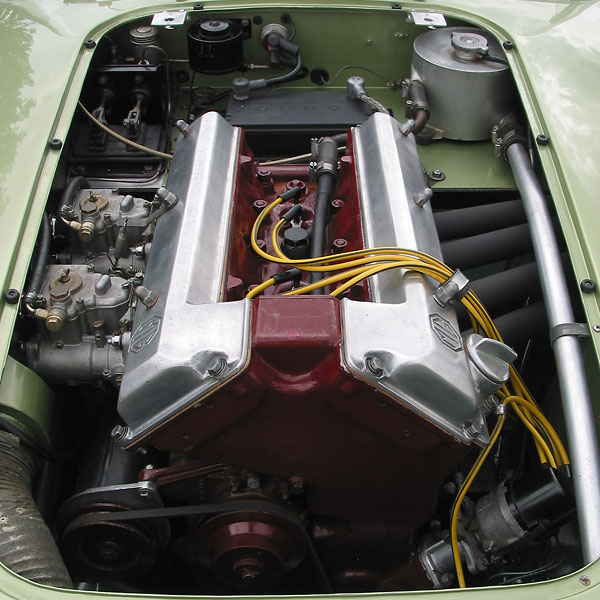
�
MGA Twin-Cam 1588cc four cylinder engine
�
 �
�
�
�
Specifications and Features
�| Note: the following specifications are "as currently configured" unless otherwise noted. | �
|
| Engine: | �MGA Twin-Cam 1588cc inline four cylinder (BMC B-series with a special �
aluminum head. Note: EX186 was probably originally fitted with an�
earlier 1489cc version of the engine, although this has not yet been �
confirmed. Details like compression ratio and cam profiles are also�
unknown.) The original oil pan has been installed; unlike a stock �
finned-aluminum Twin-Cam pan, EX186 features a specially fabricated �
steel pan with approximately 10 quart capacity. | �
| Induction: | �dual Weber 42DCOE two-barrel, side-draft carburetors. (MG originally�
installed Weber DCO carburetors on EX186.) | �
| Ignition: | �stock MG Twin-Cam. | �
| Cooling: | �EX186 features a very thick core special aluminum radiator, marked "Morris". �
A matching aluminum oil cooler is bolted to the bottom of the radiator. �
The original aluminum coolant swirl tank is used for de-aeration. �
Apparently no coolant thermostat or restrictor plate has over been fitted. �
No cooling fan is utilized. �
After passing through the radiator, airflow is divided and ducted �
into the front wheel wells. The shape of the wheel arches and �
the unique "eyebrow" fender flares were evidently engineered �
in part to manage and increase airflow out of the fender wells.�
Note: there's no airflow over the engine and in fact the engine�
compartment is essentially fully enclosed because EX186 features �
full belly pans. | �
| Exhaust: | �custom header and stainless steel muffler built to the original �
MG engineering drawings. The header is essentially a tri-y design �
with very long primaries"; cylinders "1" and "4" are paired, as �
are cylinders "2" and "3". The primary collectors are just above �
the muffler, and the muffler functions as a secondary collector. | �
| Transmission: | �(original) standard MGA 4-speed transmission with close-ratio ("factory �
option") gear set. Stock MGA-type slave cylinder, except modified with �
the bleeder in a different position. Shortened Austin Healey 100-6/3000 �
driveshaft. | �
| Front Suspension: | �similar to stock Twin-Cam except with noticeably different upper control �
arms and with a different (all aluminum) steering rack. The front �
anti-sway bar appears to be a stock MGA part. The lower control arms �
have been lightened. | �
| Rear Suspension: | �essentially a deDion type suspension, but with some details that are �
quite different from more familiar production-car deDion suspensions (Rover P5/P6, etc.)�
Specifically, in lieu of coil springs the EX186 suspension utilizes leaf springs.�
As in all deDion suspensions, the differential is rigidly mounted, and is connected �
to the hubs with jointed halfshafts. The two hubs are connected by a rigid beam�
which runs transversely behind the differential; the beam keeps the planes of the �
hubs parallel in all situations. The leaf springs are specially constructed and are �
shorter in length but noticeably softer-sprung than standard MGA (or MGB) springs. �
The design utilizes outboard brakes (with pinch-type, cable-operated emergency �
brake feature, similar to a regular Twin-Cam system) and knee-action shock �
absorbers. No Panhard rod or rear anti-sway bar is fitted. | �
| Brakes: | �Dunlop four wheel disc brakes. Note: brake and clutch have seperate Girling�
master cylinders, and the brake master cylinder has a remote reservoir. | �
| Wheels/Tires: | �15x5.5 Dunlop peg-drive knock-off steel wheels. Dunlop bias-ply historic �
racing tires. (Note: EX186 was apparently wearing three out of its four �
original Dunlop tires when the Gunderson's acquired it. The tread was nearly �
entirely worn off!) | �
| Chassis: | �EX186's steel frame is obviously based on the standard MGA design, but all the �
dimensions are somewhat different, and the MGA's "goal post" was omitted. �
94" wheelbase, 49" track. The floorboards are riveted to the bottom of the frame �
rails. The transmission tunnel is mounted above the floorboards, and is designed �
to be conveniently removeable for service. A hinged access cover in the transmission �
tunnel facilitates checking and topping off transmission oil. | �
| Body: | �hand-made all aluminum body constructed by "Midlands Sheet Metal". �
14'5" overall length. Full, smooth, aluminum belly pan. Removeable bonnet �
(secured by two Dzus fasteners at rear). Removeable access panel for the �
cooling system. Removeable luggage compartment lid. New two-tone paint, �
carefully matched to the original colors. (Interior paint is still original.) �
Perspex three piece windscreen. (Note: the original center panel was cracked �
and required replacement, but the windshield extensions on the doors �
are still original!) Dual windhshield wipers. Original Perspex headlamp �
covers. | �
| Weight: | �1870# (not quite dry) | �
| Fuel System: | �original specially-constructed 26 gallon steel baffled fuel tank, complete �
with original specially-modified Lucas fuel level sensor. Two �
original Jaguar-type (dual-ended) SU fuel pumps. Interestingly, the �
fuel pumps are plumbed in parallel to the two respective Weber carburetors,�
without crossover. (If either pump failed, the car would have to �
stop for repair.) | �
| Electrical: | �12V positive ground electrical system. Lucas Generator. Jaguar 140 �
3-position voltage regulator, mounted on the passenger-side/cabin-side �
firewall. A modern Suzuki battery fits neatly in the original battery's �
location. All of the original wiring, switches, and instruments have �
been maintained. Two Lucas fuse blocks are mounted on the �
passenger-side/cabin-side of the firewall (giving this racecar twice as �
many fuses as a stock MGA), and interestingly all four headlamp filaments �
are seperately fused. Regular MGA starter switch and headlamp switch. | �
| Lights: | �Lucas "LeMans 24" model 7" round headlamps, as original. Interestingly, �
these lamps have replaceable bulb elements which can be accessed from �
the wheel wells. EX186 has always had clear position lights outboard of �
the headlamps. It also has taillamps with integral brake light function, �
and it also has license plate lamps, but no turn signal indicators have �
ever been fitted. | �
| Instruments: | �(from left to right, as shown below) Jaeger fuel level gauge, Smiths �
oil temperature gauge, Jaeger dual oil pressure/coolant temperature gauge, �
Smiths chronometer ("tachometer") with tattletale, and Lucas amp gauge.�
The chronometer's function is especially interesting in that the needle �
rises and falls in discernable "ratchet" steps. The tattletale feature �
records the highest engine speed registered; it's reset by a button on �
the back. All instruments are illuminated for nighttime driving. EX186 �
has never had a speedometer. | �
| Interior: | �original seats (constructed from steel tubing with aluminum pans), �
reupholstered in green vinyl to match the original. The headrest �
has been similarly reupholstered. The steel dashboard has been �
repainted in the original dark green color. The aluminum doors feature �
special aluminum hinges, but utilize standard MGA latches. (The doors �
fit properly; they open and close neatly.) The doors have cargo pockets �
built-in. A stock MGA steering wheel was utilized, albeit with the center �
removed. | �
| Other Notes: | �LeMans rules required that all cars be fitted with a passenger seat and a �
spare tire, although they wouldn't be used in the race. Interestingly, MG �
used a bungie cord to hold the spare tire in place.�
| �
Engine Installation
��
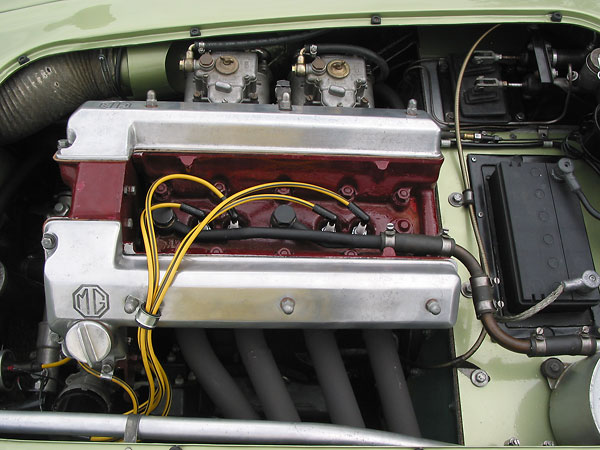
�
Dual Weber 42DCOE two-barrel, side-draft carburetors. EX186 was never equipped with S.U. carburetors.
�
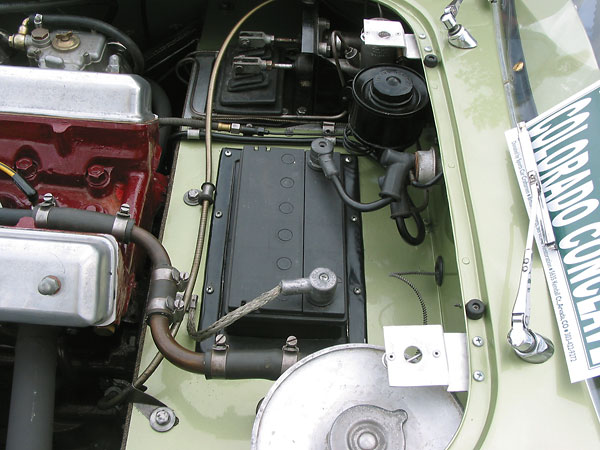
�
Foreground: the original aluminum coolant swirl tank is used for de-aeration.
�
Center: a modern Suzuki battery fits neatly in the original battery's location.
�
�
Suspension
� �
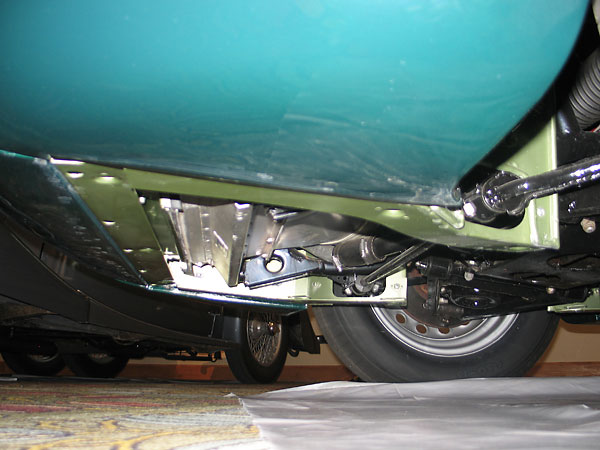
�
Smooth aluminum panels the full length and width of the bottom of the car minimized aerodynamic drag.
�
Known as "bellypans", these panels are easily removeable for access to engine and suspension.
�
(Here, and in the next three photos, bellypans have been temporily removed for our inspection.)
�
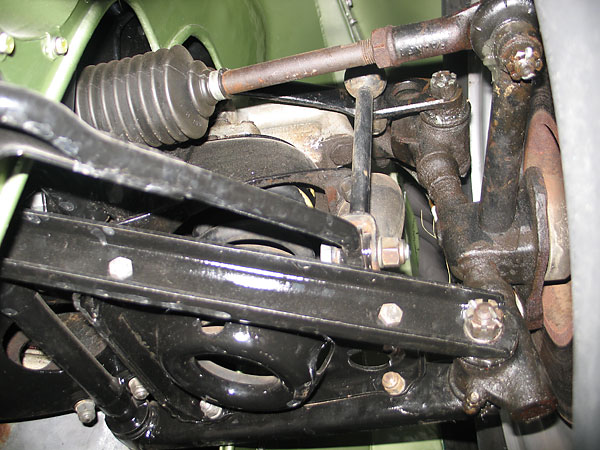
�
EX186's front suspension is similar to a stock MGA Twin-Cam. Differences include an all-aluminum
�
steering rack, noticeably different upper control arms, and lightened lower control arms.
�
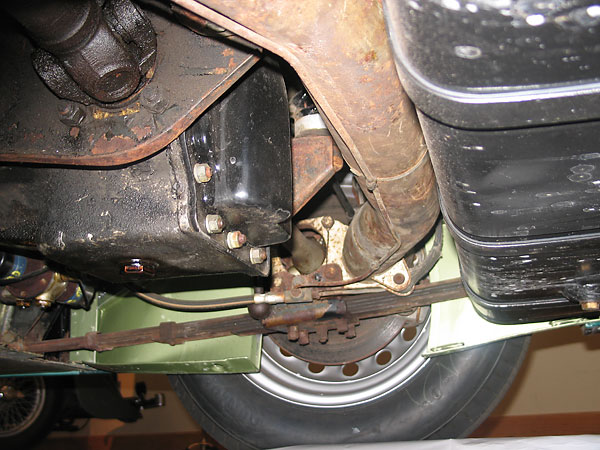
�
The rigid transverse beam of a deDion rear suspension keeps the rear wheels parallel in all situations.
�
Compared to a stock MGA, the rear springs are relatively soft. No rear anti-sway bar is employed.
�
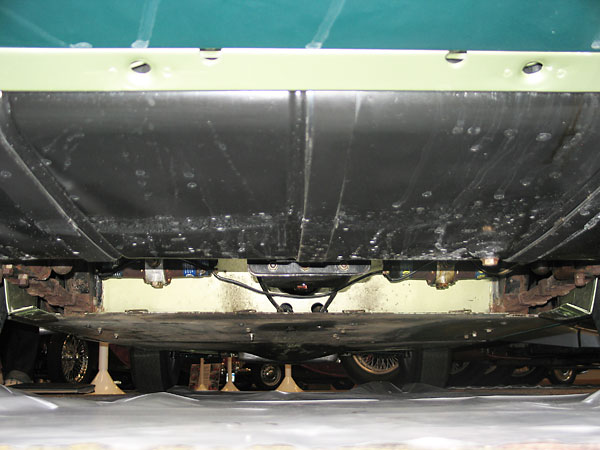
�
From the rear, with bellypan removed, you can see the fuel tank and twin S.U. fuel pumps.
�
(You can also see eight of the Dzus fastener receptor springs that would secure the bellypan.)
�
�
Interior
��
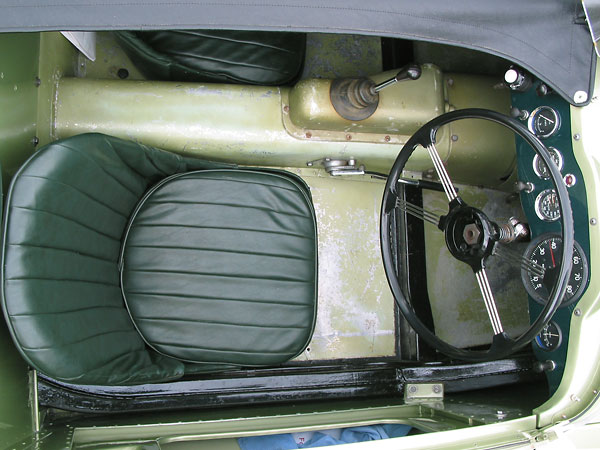
�
Left to right: Jaeger fuel level gauge, Smiths oil temperature gauge, Jaeger dual oil pressure/coolant
�
temperature gauge, Smiths chronometer ("tachometer") with tattletale, and Lucas amp gauge.
�
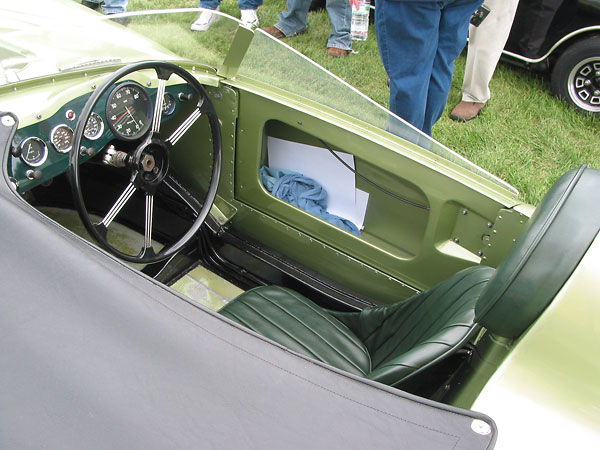
�
EX186 is a well-crafted car. The custom aluminum doors feature special aluminum hinges, but they
�
utilize standard MGA latches. The doors fit properly, and open and close quite neatly.
�
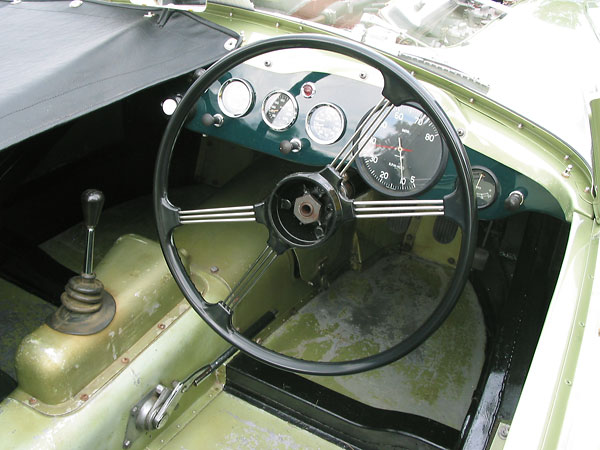
�
A stock MGA steering wheel was utilized, albeit with the center removed.
�
�
Exterior
��
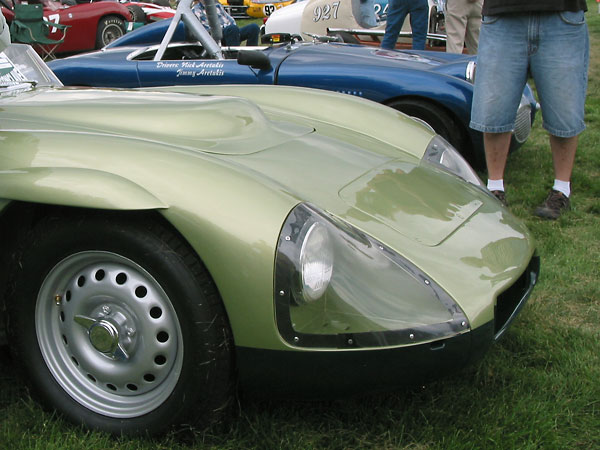
�
EX186 is shown here with its original Perspex headlamp covers, not reproductions.
�
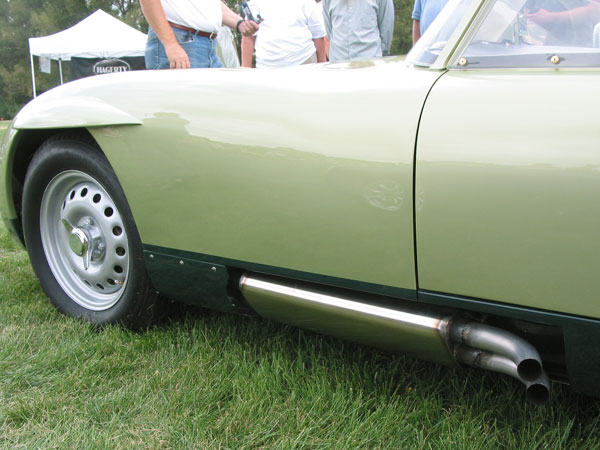
�
Custom stainless steel muffler built to the original MG engineering drawings.
�
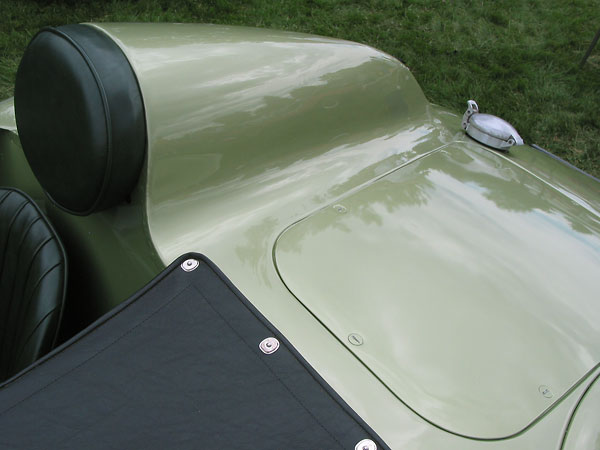
�
LeMans rules required that all cars be fitted with a spare tire. EX186's was located under this cover.
�
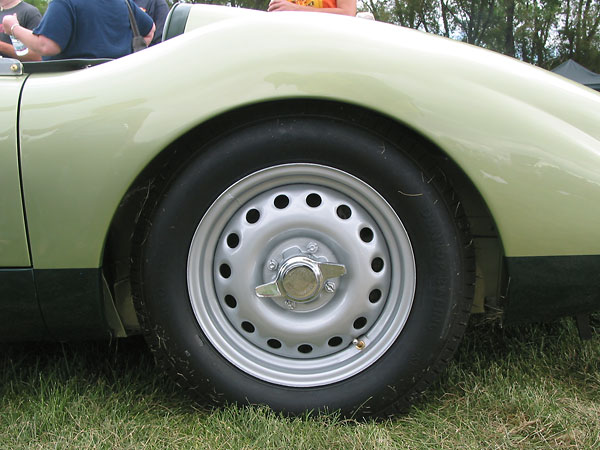
�
15x5.5 Dunlop peg-drive knock-off steel wheels. Dunlop bias-ply historic racing tires.
�
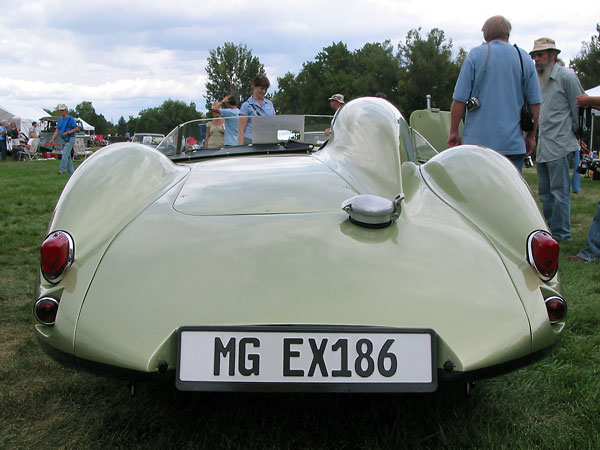
�
Endurance racing requires large capacity fuel tanks. EX186 still has its original specially-constructed
�
26 gallon steel baffled fuel tank, complete with original specially-modified Lucas fuel level sensor.
�
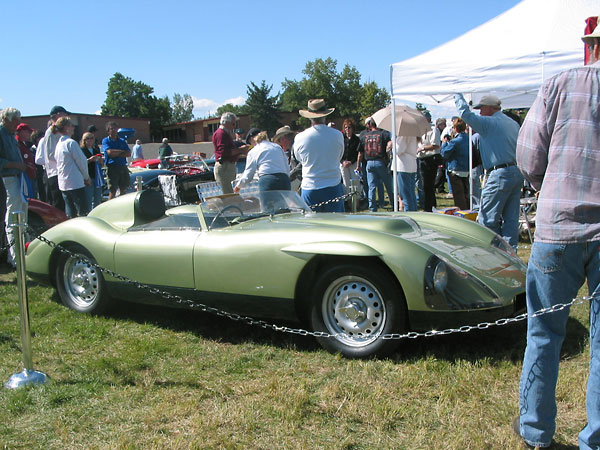
�
The original center section of EX186's Perspex three piece windscreen was cracked and required
�
replacement, but the windshield extensions on the doors are still original!
�
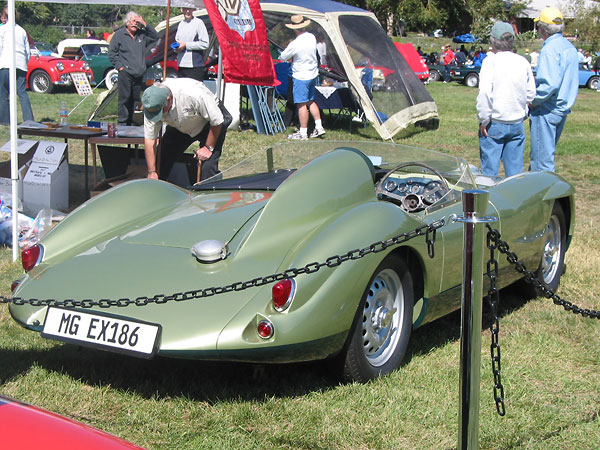
�
When MG tested EX186 on public roads, it wore British registration plate number "451 MO".
�
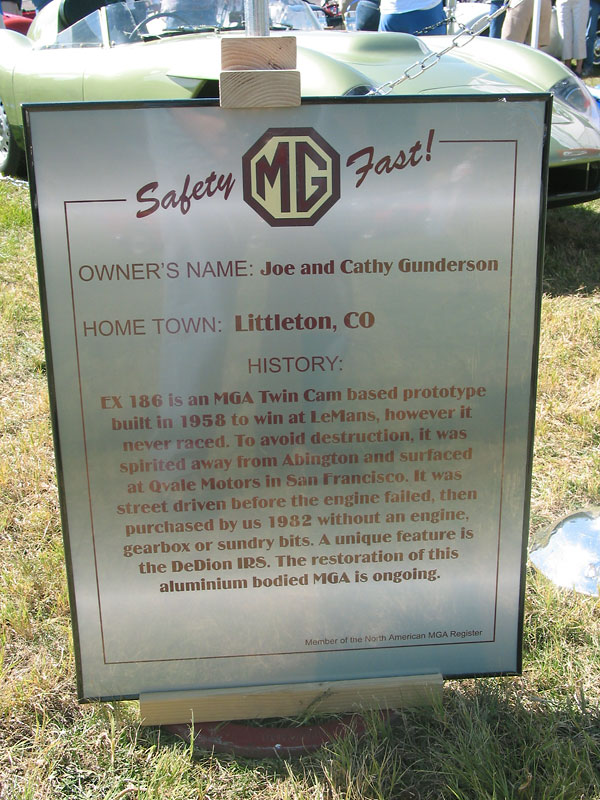
�
| Notes: | |||||||
| (1) | � In researching the history of his car, Joe Gunderson spoke to several former MG � employees who made it quite clear that MG aspired to win LeMans outright, not just � finish first within their class. Could EX186 have been that competitive? Historically,� LeMans rewards disciplined teams that drive reliable cars very consistently, lap after � lap. Few successful teams win by racing all out; instead, teams win by maintaining a � fast but consistent pace. If overall victory was indeed their goal, MG had to have been � betting much faster cars would fail before them because EX186 would have a very large � disadvantage in power. The MG Twin-Cam engine can only be enlarged to approximately� two liters displacement, so it would have been racing against engines fully fifty� percent larger. Even at that, it's a comparatively long stroke / small bore engine. � It would have had a substantial technical disadvantage in total piston area and in � piston speed. (Large piston area is favorable for making power. High piston speed � is associated with durability problems.) Through the mid-fifties, some racing � organizations followed handicapping systems whereby a smaller-engined car might � be given certain allowances, such as being allowed to run a supercharger or being � given a "head start" in terms of laps. LeMans rules didn't aide smaller cars. � Through 1958, LeMans classed cars by displacement. Starting in 1959, LeMans added � classes for non-production "prototype" cars such as EX186. The 1959 LeMans race � was dominated by two Aston Martin prototypes with 3-liter inline six engines; � they completed 323 and 322 laps respectively. The next four finishers were all � Ferrari 250's with marvelous 3-liter V12 engines. The fastest two liter car at � LeMans in 1959 was an AC Ace with a Bristol inline six engine; it completed � 273 laps to finish seventh overall, fully fifty laps off the winning pace. The� only MG that raced at LeMans in 1959 was Ted Lund's MGA, which completed 185 laps.� Had MG won outright at LeMans with MG EX186, it would have been one of the biggest � upsets in all of racing history.� | ||||||
| (2) | � Although a deDion suspension utilizing leaf springs would have been quite uncommon � for MG, this configuration was de rigueur for top-flight international racing in � the 1950's. Until Lotus introduced their "Type 16" in 1958, coil springs and � independent rear suspension were extremely unusual features in purpose-built � racecars. However, technology was changing especially quickly in this era. � By the early 1960's, racecars with deDion rear suspensions were generally uncompetitive � against racecars with unequal/unparallel wishbone independent rear suspension systems.� | ||||||
�
Photos by Curtis Jacobson, all rights reserved. The article and photos are not to be �
republished in any form without the prior written permission of BritishRaceCar.com.
�
| If you liked this article, you'll probably also enjoy these: | �|||||
 | �
Dan Leonard '49 MG TC (Special) | �
 | �
Syd Silverman '59 Lister-Jaguar | �
 | �
Kent Prather '62 MG MGA | �
| You're invited to discuss anything you've seen here on The British Racecar Motorsports Forum! | �|||||
�
Notice: all the articles and almost all the photos on BritishRacecar.com are by Curtis Jacobson.
�
(Photos that aren't by Curtis are explicitly credited.) Reproduction without prior written permission is prohibited.
�
Contact us to purchase images or reproduction permission. Higher resolution images are optionally available.
�

 �
�